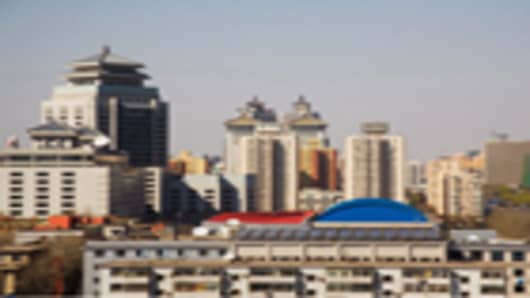China plans major bond market reform to raise the money the ruling Communist Party needs for a 40 trillion yuan ($6.4 trillion) urbanization program to buoy economic growth and close a chasm between the country's urban rich and rural poor.
The Party aims to bring 400 million people to cities over the next decade as the new leadership of president-in-waiting Xi Jinping and premier-designate Li Keqiang seek to turn China into a wealthy world power with economic growth generated by an affluent consumer class.
The urban development would be funded by a major expansion of bond markets, sources with leadership ties, and a senior executive at one of China's "Big Four" state banks, who was formerly at the central bank, told Reuters.
"The urbanization drive will push the domestic capital market liberalization agenda," the senior bank executive said on condition of anonymity. "Urbanization is Li Keqiang's big project. He has to get it right and he is willing to pursue innovation to make it a success."
(Read More: Will China's New Leadership Usher Bull Run for Stocks?)
Set to be confirmed as premier at the end of the annual meeting of China's rubber-stamp parliament, which opens next week, Li must find ways to pay for the urban development that he has made a policy priority.
Central and local governments, as well as bank loans, will fund the costs, the sources said. But, sweeping reforms to create a fully-functioning municipal bond market, boost corporate and high-yield bond issuance and actively steer foreign capital into the sector, are crucial to raising the sums of money China will need, they added.
Despite its ranking as the second-largest economy globally after three decades of stellar growth, China remains an aspiring middle-income country riven with inequality and dependent on state-backed investment.
"If we continue to walk down the path of government spending, it'll be like wearing new shoes, but walking the old road," a source with leadership ties said, requesting anonymity to avoid repercussions for speaking to foreign media without authorization.
Bank Debt Dependency
China's economy largely relies on state-directed bank lending to fund investment projects, but the massive 40 trillion yuan outlay envisaged to urbanise the rural outskirts of some 270 cities is far beyond the means of the current system.
Bank credit quality was badly strained by the economic stimulus program of 2008 that, at a headline 4 trillion yuan, was only a tenth the size of the urbanization program.
By the end of 2010, local governments had racked 10.7 trillion yuan of mainly bank debt to fund their commitments to the stimulus.
Total debt outstanding in China's fledgling bond market was 26.4 trillion yuan as of the end of January 2013, People's Bank of China (PBOC) data shows - barely a sixth of the size of the U.S. bond market - and most of what is traded is issued by policy banks to support their lending.
(Read More: Slumping Chinese Stocks? Don't Expect Beijing to Help)
The need for bond market reform has grown more urgent since December, when Li accelerated a commitment in China's 12th five-year plan to spend 40 trillion yuan on urbanisation by 2030. That money will now be spent over the next decade.
"(Li) Keqiang changed the target date during the Central Economic Work Conference last December," said a second source with leadership ties.
Currently, China lacks a properly functioning municipal bond market and is only just developing high-yield bonds, both of which would be needed to attract the investment capital sought.
And Beijing's qualified foreign institutional investor (QFII) rules stop dedicated overseas bond funds participating in the market by insisting as much as half the money they plan to invest goes into equities.
Boosting Consumption
In the face of slowing exports, the government wants to raise domestic consumption's share in the economy to close one of the world's widest gaps between rich and poor and quell discontent among those Chinese who feel they missed out on blistering economic growth of the past three decades.
The economy picked up in the fourth quarter as a spurt of infrastructure spending orchestrated by Beijing broke seven straight quarters of a slowdown.
Consumption's contribution to growth, however, fell in the fourth quarter for the third straight quarter.
About 13 percent of China's population still live on less than $1.25 per day, the United Nations Development Programme says. Average urban disposable income is just 21,810 yuan ($3,500) a year.
Meanwhile, China has 2.7 million millionaires in dollar terms and 251 billionaires, according to the Hurun Report, known for its annual China Rich List.
(Read More: Billionaire Population Hits 1,453 – Or Maybe 4,000)
Urbanisation could cure China's economic imbalances, a study by consultants at McKinsey showed last November, putting it on a path to domestic consumption-led growth within five years to replace three decades of investment and export-driven development that stoked global trade tensions.
The government hopes 60 percent of its population of almost 1.4 billion will be urban residents by 2020, from about half now, and will build homes, roads, hospitals and schools for them.
But urbanisation and market reform must go hand in hand, as simply adding to housing stock risks creating "dead cities", according to Xia Bin, a former adviser to the central bank and now head of the financial research institute at the cabinet's think-tank.
A senior financial diplomat in regular contact with Chinese officials concurred. "The focus should not just be on construction. They should also focus on creating a market," the diplomat said. "If they fail to create a market, they will end up with an urban poor much worse off than the rural poor."


